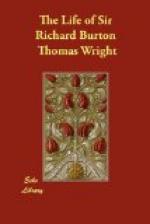The Kama Sutra (Book of Love) by
Vatsyayana.
Ananga Ranga (Stage of Love) by
Kullianmull.
Ratirahasya (Secrets of Love) by
Kukkoka.
Panchasakya (The Five Arrows) by
Jyotirisha.
Smara Pradipa (Light of Love) by
Gunakara.
Ratimanjari (Garland of Love) by
Jayadeva.
Rasmanjari (Sprout of Love) by Bhanudatta.
Of these seven books two only were issued, namely the Kama Sutra and the Ananga Ranga or Lila Shastra. The precise share that Burton[FN#395] had in them will never be known. It is sufficient to say that he had a share in both, and the second, according to the title page, was “translated from the Sanskrit and annotated by A. F. F. and B. F. R.,” that is F. F. Arbuthnot and Richard Francis Bacon—the initials being purposely reversed.
115. The Kama Sutra.
When commencing upon The Kama Sutra, Indraji—for he was the actual translator—found his copy, which had been procured in Bombay, to be defective, so he wrote to Benares, Calcutta and Jeypoor for copies of the manuscripts preserved in the Sanskrit libraries of those places. These having been obtained and compared with each other, a revised copy of the entire work was compiled and from this Indraji made his translation. “This work,” he says, “is not to be used merely as an instrument for satisfying our desires. A person acquainted with the true principles of this science, who preserved his Dharma (virtue or religious merit), his Artha (worldly wealth) and his Kama (pleasure, or sensual gratification), and who has regard to the customs of the people, is sure to obtain the mastery over his senses. In short, an intelligent and knowing person, attending to Dharma, and Artha and also to Kama, without becoming the slave of his passions, will obtain success in everything that he may do.” According to Vatsyayana, Kama should be taught just as is taught—say, hygiene or political economy. “A man practising Dharma, Artha and Kama enjoys happiness both in this world and in the world to come.” It must not be supposed that the work is entirely erotic. There are also directions for one’s conduct at religious festivals, especially that in honour of Saraswati,[FN#396] picnics, drinking parties and other social gatherings. Still, the erotic preponderates. The work is mainly a handbook on Love. One is informed respecting what women are or are not worthy of affection. There are full instructions respecting kissing, an art which is not so easy to learn as some persons think. Still, a man who could not kiss




